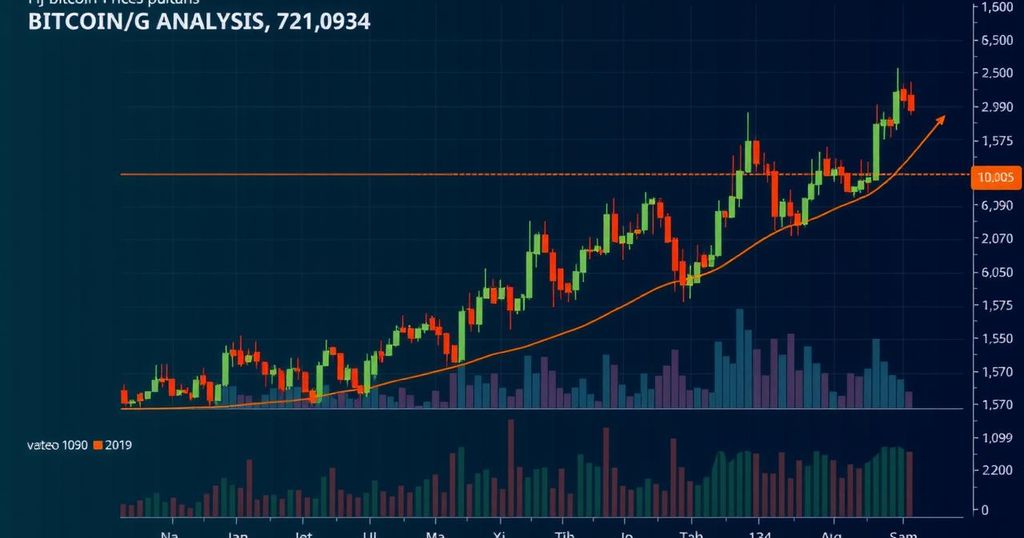Forecasting Bitcoin Prices: An Analysis of Annualized Rates of Return
The article explores the forecasting of Bitcoin prices through annualized rates of return (AAR), focusing on Michael Saylor’s proposed 29% AAR as a base case. It emphasizes the volatility of Bitcoin and the need for cautious interpretation of price projections. The long-term compound interest effects are highlighted, revealing how modest changes in annual returns can lead to substantial differences in terminal wealth over time. It also addresses skepticism regarding Bitcoin’s future and suggests that sustained appreciation could radically impact the economy.
Forecasting the price of Bitcoin necessitates an understanding of annualized rates of return (AAR). At the Bitcoin 2024 conference held in Nashville, Michael Saylor proposed a base case of a 29% AAR. This methodology facilitates a straightforward projection of Bitcoin’s future prices, beginning with the price recorded on August 1, 2024, as the baseline. Various annualized rates of return can be assumed to evaluate how Bitcoin’s price may evolve over the following four years. It is critical to approach these forecasts with caution; none of the projected estimates should be regarded as definitive predictions. The inherent volatility of Bitcoin implies that even an AAR of 20% may yield both negative and positive annual returns, necessitating an interpretation centered on potential terminal prices by August 1, 2028, rather than isolated year-to-year fluctuations. Although the projected returns appear elevated in comparison to current asset returns, such as equities at 8% or Warren Buffett’s portfolio averaging 22%, they remain comparatively modest relative to Bitcoin’s historic returns. The long-term projections, extending for 20 years, underscore the significance of compound interest, where slight variations in annual returns can drastically alter terminal wealth. This phenomenon is evident even within a shorter ten-year forecast. Bitcoin’s unique characteristic lies in its historical pattern where short-term average returns often fall short of long-term averages. For instance, a three-year return could be 0%, while over a 14-year span, it could reach 150%. Thus, a lower return exhibited in initial projections may contradict a higher return projected over an extended period. The focus should remain on terminal values rather than interim results. Adopting the rate-of-return approach offers clarity, as it aligns with common financial vernacular; however, the chosen rate significantly influences future price trajectories. Historically, Bitcoin’s rate of return exhibits substantial variation based on both the analysis timeline and specific transaction dates—buying during bearish conditions and selling in bullish times results in vastly different outcomes. Despite skepticism regarding Bitcoin’s future performance—given its unique beginnings and the fact that inflationary rewards such as issuing 50 bitcoins per block can never recur—a conservative projection based on early gains still indicates future returns that surpass returns on most contemporary assets. Consequently, the critical inquiry revolves not around a potential depreciation of Bitcoin’s value but rather its sustained appreciation. Should this trend continue, the implications for economic structures could be transformative. Further examination of Bitcoin’s potential impact on the economy will be addressed in subsequent communications.
The article discusses the methodology of forecasting Bitcoin’s prices using annualized rates of return, particularly emphasizing the significance of a calculated AAR and the role that volatility plays in price projections. The discussion stems from insights shared at the Bitcoin 2024 conference and highlights the unique characteristics of Bitcoin as an asset class, drawing contrasts between historical returns and contemporary expectations. The importance of compound interest over extended periods is also critically evaluated, illustrating the discrepancy between short and long-term gains. Moreover, it touches on the skepticism about Bitcoin’s future based on its past and the premise that its unique beginnings may not be replicated, ultimately proposing a forward-looking perspective on Bitcoin’s potential future growth.
In summary, utilizing annualized rates of return to forecast Bitcoin’s price presents both opportunities and challenges, given the asset’s volatility and historical performance variations. The method offers a clear framework for projection while requiring a careful consideration of the rates assumed. Ultimately, the key question to ponder is not about potential declines in Bitcoin’s value, but rather the implications of its sustained growth, which may significantly alter our economic landscape.
Original Source: www.forbes.com








Post Comment